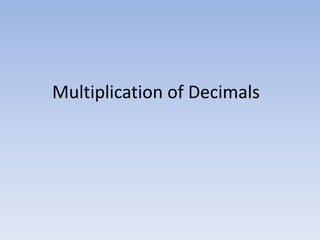
Multiplication of decimals
- 2. What is a Decimal? A decimal is similar to a fraction as it is not a whole number. All fractions can be represented in decimal form but not all decimals can be represented as a fraction.
- 3. Simple Multiplication of Decimals 0.7 * 0.5 =0.35 For decimals with only values in the tenths you can do it like a regular multiplication problem and then bring the decimal to the front e.g. 5 groups of 7 is 35
- 4. Visual representation Each column and row equals 0.1, therefore each box represent 0.1*0.1 or .01. The entire table therefore equals 1For 0.7 * 0.5 0.5 0.7
- 5. Visual representation The blue squares represent 0.7 of a whole and the squares with the grid represent 0.5As a result, squares which are both blue and have a grid represent 0.7 * 0.5 . By counting them we notice there are 35 out of 100. This is expressed as 0.35
- 6. Visual representation By counting them we notice there are 35 out of 100. This is expressed as 0.35 0.7 * 0.5 = 0.35 0.5 0.7
- 7. We need 100 square when multiplying decimals which only have tenths if we wanted to multiply decimals which have values in the hundredths we would need 1000, or 10000 for thousandths and so on. Therefore I would only recommend this method for simple decimal multiplication to get a grasp on the concept.
- 8. For multiplication of more difficult decimals I would recommend long multiplication. (Or any other method used for multiplying numbers that have more than one digit, e.g. Russian, Napier’s)For example we will multiply 0.548 * 0.254 using long multiplication.
- 10. so 548 * 254 = 139192now to find where we put the decimal we look at the original numbers of 0.548 and 0.254 and count the places to the right of the decimal place. There are six, so our value for 548 * 254 moves six spots right in place value (the hundred thousand value move to the tenths an so on.)Hence 0.548 * 0.254 = 0.139192
- 11. Fractions Another way we can look at decimals is as fractions or as a multiplicative inverse. 0.7 is the same a 7/10 and 0.5 is 5/10 so another way of multiplying 0.7 and 0.5 is by saying 7/10 * 5/10 which can be rearranged to 7*5/100. Similarly, we can say 0.548 = 548/1000 and 0.254 = 254/1000 and therefore 0.548 * 0.254 = 548 * 254/1000000
- 12. As a Multiplicative inverse Multiplicative inverses generally aren’t introduced until high school but it may be an easy way for some. A multiplicative inverse for a number, say x is, 1/x , or denoted x-1 , so if we have a decimal which we can changed into a unit fraction then we can use this method to multiply. For example 0.25 is equal to 1/4 and .5 is equal to 1/2. So if we wanted to multiply .25 * .5 we could say 4-1 * 2-1 which would of course equal 8-1 or 1/8.0.1 2 5Use longhand division to bring 1/8 to a decimal 8)1.02040 1/8 = 0.125 and therefore 0.25 * 0.5 = 0.125
- 13. Linking methods Mathematically Throughout the presentation I have used the same equations and obtained the same results in order to show that the different methods all work. The first two examples for 0.7 * 0.5=35 show 7 groups of 5 and 7 rows of 5 so are practically the same. After the long multiplication we moved our result six places to the right to compensate for the decimal places in the original equation. This is the same as dividing by one million, so we could show the process we used as 548 * 254/1000000 which is what we produced when displaying 0.548 and 0.254 as fractions before multiplying.